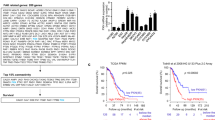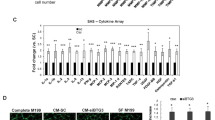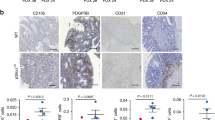Abstract
The p53 tumor-suppressor gene is inactivated in over 50% of all human cancers. In normal cells, p53 induces growth arrest and apoptosis in response to DNA damage. We show that p53 acts as potent tumor-suppressor gene independent of its well-documented effects on tumor-cell proliferation and apoptosis. p53 activates target genes in a murine fibrosarcoma cell-line but does not affect tumor cell-cycle progression or survival. Exogenous expression of wt-p53 does, however, block the angiogenic potential of the tumor cells resulting in formation of dormant tumors in vivo. These data provide evidence that: (1) p53 acts as a tumor suppressor gene independent of its anti-proliferative effects; (2) By inhibiting angiogenesis p53 can indirectly induce apoptosis in vivo but not in vitro; (3) p53-gene therapy which alters a tumors angiogenic potential, can revert tumors to a dormant phenotype.
This is a preview of subscription content, access via your institution
Access options
Subscribe to this journal
Receive 50 print issues and online access
$259.00 per year
only $5.18 per issue
Buy this article
- Purchase on Springer Link
- Instant access to full article PDF
Prices may be subject to local taxes which are calculated during checkout
Similar content being viewed by others
Author information
Authors and Affiliations
Rights and permissions
About this article
Cite this article
Holmgren, L., Jackson, G. & Arbiser, J. p53 induces angiogenesis-restricted dormancy in a mouse fibrosarcoma. Oncogene 17, 819–824 (1998). https://doi.org/10.1038/sj.onc.1201993
Received:
Revised:
Accepted:
Published:
Issue Date:
DOI: https://doi.org/10.1038/sj.onc.1201993
Keywords
This article is cited by
-
Tumor dormancy and the neuroendocrine system: an undisclosed connection?
Cancer and Metastasis Reviews (2013)
-
Inhibition of tumor angiogenesis by p53: a new role for the guardian of the genome
Journal of Molecular Medicine (2007)
-
Antiangiogenic gene therapy of cancer: recent developments
Journal of Translational Medicine (2004)
-
Tumorigenesis and the angiogenic switch
Nature Reviews Cancer (2003)
-
Aerosol delivery of PEI–p53 complexes inhibits B16-F10 lung metastases through regulation of angiogenesis
Cancer Gene Therapy (2002)



